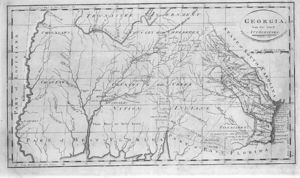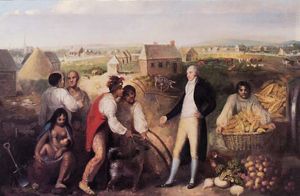- Profile
- Images
Location: [unknown]
- War of 1812 Project page
- Project Resource Page
- Project Images
- Indian Nation in the War of 1812
- Creek War, Battles and Forts
- The Old Federal Road

|
| The Georgia Frontier 1794 |
Contents |
Georgia and the War of 1812
The War of 1812 was fought between the United States and Britain between 1812 and 1815.
Influential Leaders

|
| Benjamin Hawkins and the Creek Indians, 1805 |
Col. Benjamin Hawkins
General John Floyd
At the beginning of the War of 1812, General Floyd commanded a force at Point Peter near St. Marys in Camden County. In September, 1813, in response to the threats and to subdue the Red Stick rebellion, General John Floyd was ordered to command Federal troops who were assembled at Camp Hope on the Ocmulgee River. These forces constructed supply forts in a defensive line along the Federal Road from the Ocmulgee River to the Alabama River.
Major General John Floyd- "Commander of Georgia Militia." In September 1813, Floyd assembled 3,600 Georgia troops at Fort Hawkins.
In 1997 Mary Faith Wilson, a Floyd descendant, endowed the General John Floyd Fund at the Georgia Historical Society.
William McIntosh

|
| Taskanugi Hatke McIntosh. |
William McIntosh (Taskanugi Hatke) a leader of the Creek settlement of Coweta, and a Creek Chief of Scottish descent, thought that by centralizing Creek leadership on a national council he could maintain Creek autonomy in the face of aggressive U.S. expansion. (and make a fortune for himself)
Admiral Sir George Cockburn
10th Bt He directed the capture and burning of Washington on 24 August 1814. He cruised relentlessly up and down the Atlantic coast in 1813 and 1814, seizing American shipping, disrupting commerce, and raiding the ports.
Forts or Stockades established along the Georgia frontier.
Fort Wilkinson
Fort Wilkinson, established in 1797, was on the Oconee River, near Milledgeville, the capital of Georgia, the Oconee River was the western boundary for the extending territory. The Treaty of Fort Wilkinson on Oconee River was signed here in June 1802. The treaty was signed for the U. S. by James Wilkinson, Brigadier General of the Army, Benjamin Hawkins, Creek Indian agent, and Andrew Pickens of South Carolina. Abandoned for Fort Hawkins in 1806 as the boundry continued westward.
Fort Hawkins
Fort Hawkins was built by the United States in 1806 and through 1824, it was a place of "relatively great economic, military, and political importance." For the Creek Nation, it was a center of the deerskin trade with European Americans, who had a trading post and processing factory there, but for them it was most important as related to their sacred grounds at Ocmulgee Old Fields. This continued to be a significant social and ceremonial center until the Removal Act .[1]The city of Macon GA. is the present location of Fort Hawkins.
Fort Mitchell
Established by Gen. John Floyd just across the Chattahoochee River in present-day Alabama.The first Fort Mitchell, built in 1813 as an outpost during the Creek War and War of 1812 and represents the military aspect of Manifest Destiny. It was named for David Brydie Mitchell, a governor of Georgia. The Chattahoochee Indian Heritage Center has a ceremonial flame memorial to the Creek nation here at the Fort Mitchell Historic Site
Fort Hull
Fort Hull was constructed in January of 1814 to serve as a supply base for General John Floyd’s army. Colonel Homer V. Milton assumed command of the post once Floyd retreated back to Georgia following the Battle of Calabee Creek. The fort site is currently unmarked, and located on private property off County Road 45 in central Macon County, Alabama
Three main theaters of operation in Georgia:
(1) Creek War of 1813-14; (2) the British blockade; (3) British occupation of St. Marys (central Georgia militia were sent here) and Cumberland Island in 1814-15.

|
| John Floyd at Horseshoe Bend. |
Creek War of 1813-14
1812
General Newnan commanded the Georgia volunteers as Captain of the Militia in two actions with the East Florida Indians. In the hottest months of 1812, Newnan added to his reputation of military prowess when he led a small unit of Georgia volunteers down to Florida to attack the Native Americans that dared to welcome slaves into their numbers. They planned to decimate entire villages by killing the inhabitants and burning them to the ground. The plan failed miserably when the militia turned out to be unprepared to meet the Seminoles on their own turf. They were badly beaten and had to beat a hasty retreat with many sick men and no food. Newnan detailed the incident in a letter to his commander, which highlighted his skills, greatly exaggerated the number of Seminole deaths and blamed other officers for some of the problems. This Florida encounter greatly added to his military reputation.[2]
In 1812, Bolek and his brother King Payne began raiding frontier settlements along the Florida Georgia border. Seminole bands fought several engagements with militia forces, his brother King Payne was killed in 1812, and Bolek suffered serious wounds at the same time against Georgia militia forces, under Daniel Newnan. The following year hundreds of Seminole villages were destroyed. Warfare between the Seminole and Georgia settlers was one of the reasons for the US involvement in the Creek War of 1813-1814.[3]
Colonel Newnan, of Georgia, the Inspector-General of that State, who was a volunteer, offered to lead a party against Payne's town in Alachua. Organizing a command of one hundred and ten men only, from the patriots in Florida. Captain Tomlinson Fort, of the Milledgeville Volunteers, Lieutenants Broadnax and Reed, and Captain Humphreys, with a detachment of marines, were among Newnan's troops.[4]
1813
"The Georgia brigade consisting of two regiments of Infantry, one horse troop, or mounted men, one rifle battalion, and one Artillery company was mustered into service at Fort Hawkins on the Ocmulgee, about the 20th September, 1813, under the command of Brigadier General John Floyd, of Georgia, to which was afterwards added five or six Indian warriors of the Friendly party."[5]
November 29, 1813
Battle of Autossee or Auttose, Montgomery County, Alabama
- General John Floyd's Georgia Militia, from Fort Mitchell
- Georgia Militia, 950 men
- Chief Mad Dog's Tookabatchee warriors, 400 warriors
January 26, 1814
Calabee Valley, seven miles from Tuskegee, Alabama. Thirteen hundred Creek warriors mounted a surprise attack against the encamped army on the banks of Calabee Creek on January 27, 1814. The assault was blunted by the Georgians' use of artillery and superior fire. Nevertheless, the attack succeeded in dispiriting the Georgians, and Floyd retired to Fort Hull. Soon afterward, Floyd was forced by his army's enlistment expirations to return to Fort Mitchell, leaving a small garrison at Fort Hull.[6]
- General John Floyd's Georgia Militia, from Fort Mitchell, General John Floyd commanding
- Georgia Militia, 1200 men Captain William Varner's Mounted Militia Company
- Chief Mad Dog's Tookabatchee warriors, 400 warriors
Fort Hull, under the command of Colonel Homer Milton, was reinforced and spent the next several months continuing to harry the Creeks. He established the fortified posts of Fort Bainbridge and Fort Decatur in the disputed areas. Floyd's and Milton's activities ensured supplies that aided in Jackson's successful battle at Horseshoe Bend, which in turn culminated in the defeat of the hostile Creeks on March 27, 1814.
The British Blockade
No serious British threat emerged to endanger the Georgia coast, due to British efforts against Napoleon. In 1814 all that changed. Napoleon's defeat in Europe freed thousands of experienced British regulars to move across the Atlantic.
British occupation of St. Marys

|
| Admiral Sir George Cockburn . |
January 10, 1815, British forces under the command of Admiral Sir George Cockburn landed on Cumberland Island in an effort to tie up American forces and keep them from joining other American forces to help defend New Orleans, Louisiana.
Admiral Cockburn, by the end of January 1815, had solidified his base of operations and was under orders to await the arrival of Major Edward Nicolls, leading a joint force of British soldiers, Native American allies, and freed blacks from the Gulf Coast.
The British finally evacuated St. Marys after the ratification of the treaty on February 17, 1815.
Resources
Bibliography
| Name | Branch | Rank | Unit |
| Hughey, John | Militia | 3rd Sgt | John Cunningham's Company |
| McAlpin, Alexander | Militia | Lieutenant | 2nd Regiment, Captain Thomas' Co. |
| McClendon, Jeptha Cooper | Militia | Unknown | Wootens Detachment |
| Richardson, Richard | Militia | Fifer | 2nd Regiment |
| Rustin, William | Militia | Private | 2nd Regiment, Captain Robert Quarterman's Co. |
Sources
- ↑ http://thelamarinstitute.org/images/PDFs/publication_124.pdf
- ↑ http://www.cowetalife.org/blog/2014/8/23/historical-highlight-daniel-newnan
- ↑ Indian Nation in the War of 1812
- ↑ http://genealogytrails.com/fla/HISTORYOFFLORIDA/HistoryChapter17.htm
- ↑ Thomas H. Davis Diary
- ↑ http://www.georgiaencyclopedia.org/articles/history-archaeology/war-1812-and-georgia
- Login to edit this profile and add images.
- Private Messages: Contact the Profile Managers privately: David Wilson and Terri Rick. (Best when privacy is an issue.)
- Public Comments: Login to post. (Best for messages specifically directed to those editing this profile. Limit 20 per day.)



[has Cockburn on the Coast of Georgia page 690, Insurrection in the East, page 740, Floyd, The Georgian retire to their frontier page 776, and others] Lossing, Benson John, The pictorial field-book of the war of 1812; or, Illustrations, by pen and pencil, of the history, biography, scenery, relics, and traditions of the last war for American Independence, New York, Harper & Brothers, 1896; digitized, archive.org; https://archive.org/details/fieldbookswar181200lossrich/page/n14
Embed: <iframe src="https://archive.org/embed/fieldbookswar181200lossrich" width="560" height="384" frameborder="0" webkitallowfullscreen="true" mozallowfullscreen="true" allowfullscreen></iframe>
You'll need to add this template to your profiles of 1812 participants from Georgia: {War of 1812 | Georgia} (use double Curly brackets- {{ }})
The result will beService started:
Unit(s):
Service ended:
Then the profile will show up here: https://www.wikitree.com/wiki/Category:Georgia%2C_War_of_1812
Allan